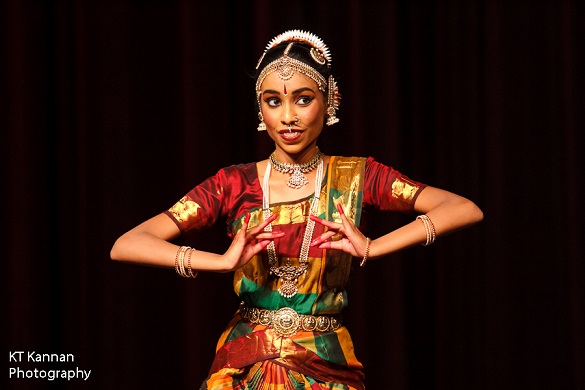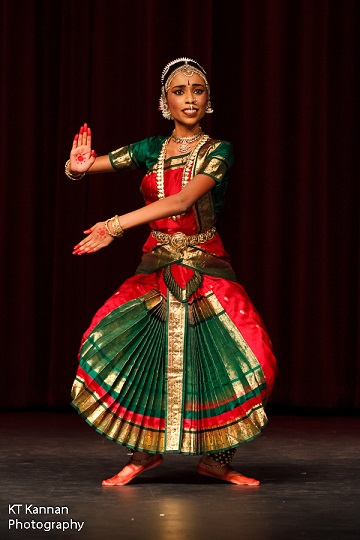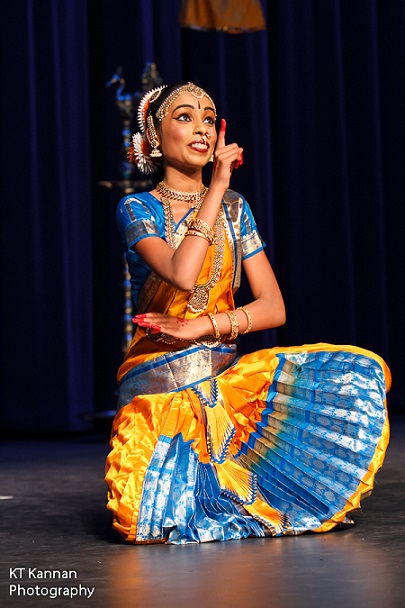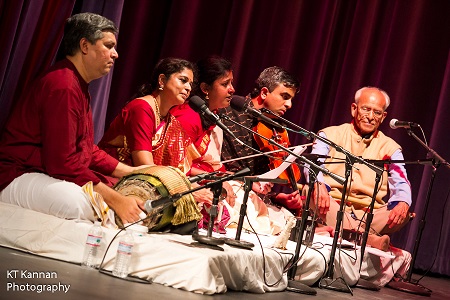Contribute
| Arangetram: Priya Venkatesh |
S. Ramamoorthy
10/23/2013
A Delightful Dedication – Priya Venkatesh’s arangetram I recalled the famous quote, “There is no wisdom or
knowledge, no device, no art, no craft or action that is not found in Natya “,
when I was sitting in for Priya’s arangetram recently. The happy outfit was
held on Sunday, Oct. 6th at the artistic auditorium which is part of
the National Heritage Museum in Lexington, MA.
Priya came under the tutelage of Guru Jeyanthi Ghatraju about four years
ago. Over these years, she evinced enormous interest in learning this divine
art and put in hard work and sincere application. These helped groom Priya’s
interest and raised her to the arangetram performance level. Priya started her arangetram recital with an invocation
consisting of three items – first was a traditional Pushpanjali, composed by Guru Govindarajan in ragam Bhoopalam.; the
second was Paalum theli thenum, a short
verse by Saint Poet Avvaiyar in praise of Lord Ganesha; the third piece was a keerthanam, Namaste asthu Bhagavan, a
composition of Swami Shanthananda in ragam
Basant Bahar. The next item was the alarippu
set in Chathusra nadai and Priya traversed this pure dance with good poise. She presented a rare kavuthuvam, called Thiruvalangadu
Kali kavuthuvam in ragam
Hamsadhwani next; the prelude slokam
was a composition of Guru K.Lalitha in ragamalika.
Priya proved emphatically what is said of Bharatanatyam
in this piece, “poetry in motionâ€; Priya presented her jathiswaram
in ragam Bilahari, a composition of
Guru Madurai R Muralidharan; an ornamental piece without any particular
emotion, the jathiswaram took the emotion of the underlying ragam and Priya portrayed piety quite
effectively. The evening’s central piece, the varnam, was Sadhinchene,
a time-tested gem of a composition by Saint Thyagaraja in ragam Arabhi. Priya lived through the soul-stirring lyrics of the
composition and enthralled the audience with her deft dance movements, studded
with elegant hand gestures and emphatic facial expressions. She narrated three
stories – plight of Arjuna in the Kurukshetra
war, friendship of Sudhama/Kuchela and Krishna and the devotion of Shabari to
Lord Rama. Her portrayal of the innocent old lady, Shabari, moved so many in
the audience. On the whole, the varnam
culminated as a natya aradhana to the great saint. In a margam
format, entertaining padhams follow
an emotional varnam. Priya presented Mayil Vahana in praise of Lord Muruga in ragam Mohanam. The audience enjoyed
the prelude jathis depicting a
peacock’s dance and the lilting chittaswarams
in this padham. Priya then presented Kapali
nee in ragam Palini and composed
by Guru Lalitha Sivakumar. She vividly
brought out two stories related to the Kapaleeshwarar temple in Mylapore,
Chennai. Many in the audience had a personal connection with the temple and
thoroughly appreciated her depiction of Shiva, Brahma and Parvathi highlighting
the temple’s history. Priya transformed into an adoring mother of baby Rama in
Tumak chalathu as visualized by Saint Tulsidas. How a 16-yr old can provide so
much depth into the composition was quite amazing! The choreography was simple
and catchy. The concluding number was thillana in ragam Kadhanakudhookalam by Dr. M. Balamuralikrishna. Priya enjoyed every bit of the tempo and
embellished it with elegant traversal and lilting twists – all with effable
ease at every stage. Priya presented her mangalam as a solemn bhajan in praise of
Bhagavan Baba, transporting the audience to a higher spiritual level. In a Bharatanatyam recital, the orchestra plays a vital role
in enriching the program with synergy and coherence, all the while supporting
the dancer. Guru Jeyanthi Ghatraju’s
nattuvangam had well-punctuated jathis, vibrating eloquently. She has a
particular approach in selecting pieces suited to her student dancer’s
abilities and the host family’s audience. Her choreography was crisp, clean and
deep, reflecting the amount of research that has gone in from vision to
presentation. Vocalist, Prafulla Velury, an accomplished Kuchipudi
performer herself, adorned the songs with her sweet and melodious voice.
Mridangist, Gaurishankar Chandrashekar, an experienced percussionist, gave
ample and unobstructed support to the debutante, embellishing the rhythm
whenever it was appropriate. Violinist, Surya Sundararajan, another experienced
musician from this area, scored richly in his melodious accompaniment and
contributed highly to the overall program. Flautist, Dr. Suresh Mathur, a
senior musician, has been an ever-guiding force and provided subtle but strong
support on his flute. For Priya, the debutante,
it was a dream come true and that shone through the entire program. To those
who know Priya well, it was a pleasant surprise to see Priya as a transformed
dancer as she was completely in line with what was expected of her. In spite of
being in the midst of pressing academic commitments, the fact that Priya
decided to pursue and complete her arangetram bears testimony to her passion
and commitment towards this art form. I would like to conclude this coverage with a realistic
quote from Dr. Wayne Dyer, “When you dance, the purpose is not to get to a
particular place on the floor; it’s to enjoy each step along the way!†Now that the initial journey has started, here is wishing
Priya continued success in all her endeavor and may dance be part of her life
forever!
You may also access this article through our web-site http://www.lokvani.com/



